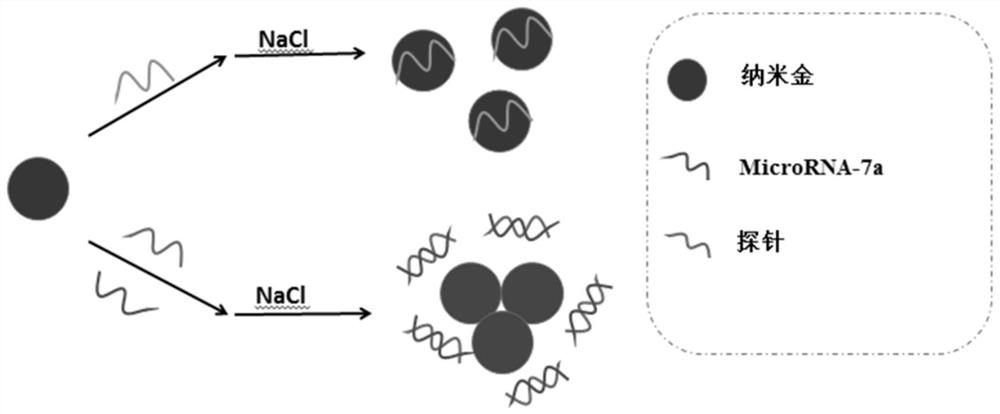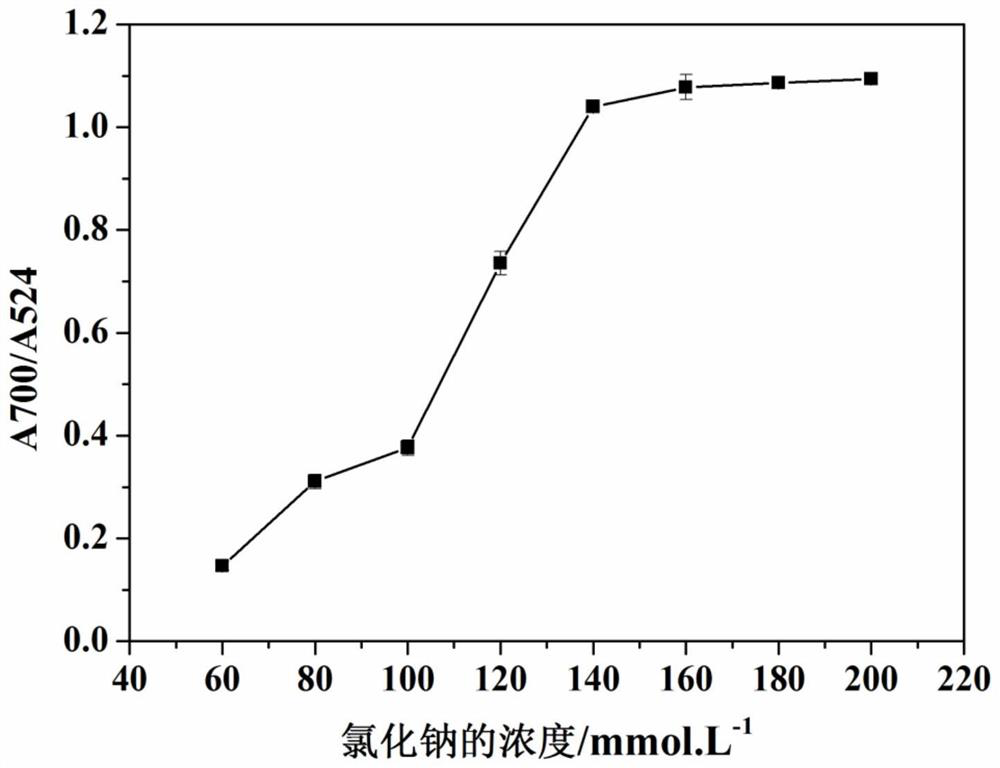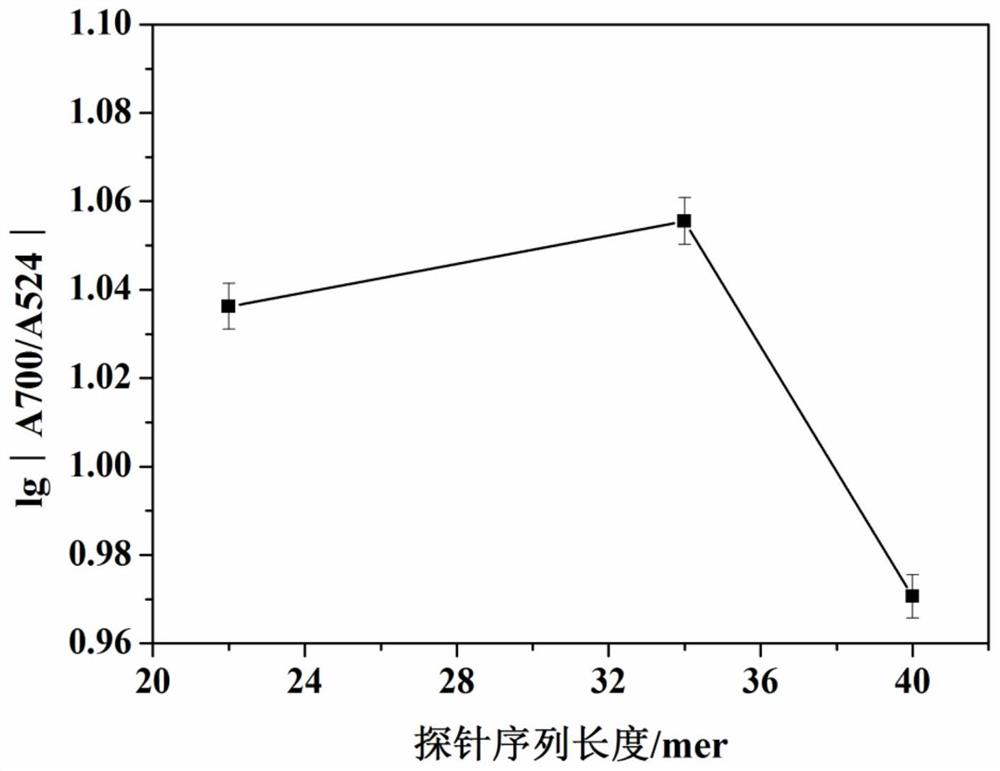A rapid detection method for microRNA-7a based on nano-gold colorimetry
A detection method, nano-gold technology, applied in the fields of molecular biology and nucleic acid chemistry, can solve the problems of destruction, cumbersome biological sample activity, high instrument cost, etc., and achieve the effect of mild reaction environment and pollution-free, short detection cycle and fast analysis speed
- Summary
- Abstract
- Description
- Claims
- Application Information
AI Technical Summary
Problems solved by technology
Method used
Image
Examples
Embodiment 1
[0029] (1) Preparation of gold nanoparticles: Pipette 100 mL of chloroauric acid solution with a concentration of 0.01% by mass and pour it into a round-bottomed flask, place it in an oil bath, heat it to boil, and quickly add 1.5 mL with a concentration of 1% by mass % sodium citrate solution as a reducing agent, continue heating for 15 minutes, observe that the color of the solution gradually changes from initial light yellow to wine red, and finally stop heating and cool to room temperature, and the whole process is carried out under stirring. Gold nanoparticles with a diameter of about 24nm were obtained.
[0030] (2) Design the probe Probe (base number 34mer) complementary to the target miRNA-7a.
[0031] (3) After mixing the target miRNA-7a with a concentration of 131.57 nmol / L and the probe Probe with a substance amount of 80 pmol and a base number of 34mer, place it at 38°C for 30 minutes and hybridize to obtain a hybridization mixed solution.
[0032] (4) Put the mix...
Embodiment 2
[0038] (1) Preparation of gold nanoparticles: Pipette 100 mL of chloroauric acid solution with a concentration of 0.01% by mass and pour it into a round-bottomed flask, place it in an oil bath, heat it to boil, and quickly add 1.5 mL with a concentration of 1% by mass % sodium citrate solution as reducing agent, continue to heat for 15 minutes, observe that the color of the solution gradually changes from initial light yellow to wine red, and finally stop heating and cool to room temperature, and carry out under stirring throughout the whole process; the obtained particle size is approximately 24nm gold nanoparticles.
[0039] (2) Design probes complementary to the target miRNA-7a, with base numbers of 22mer, 34mer, and 40mer.
[0040](3) After mixing the target miRNA-7a with a concentration of 131.57 nmol / L and 80 pmol of substances, probes with base numbers of 22mer, 34mer, and 40mer were mixed, and hybridized at 38°C for 30 minutes to obtain hybridization mixture.
[0041...
Embodiment 3
[0047] (1) Preparation of gold nanoparticles: Pipette 100 mL of chloroauric acid solution with a concentration of 0.01% by mass and pour it into a round-bottomed flask, place it in an oil bath, heat it to boil, and quickly add 1.5 mL with a concentration of 1% by mass % sodium citrate solution as reducing agent, continue to heat for 15 minutes, observe that the color of the solution gradually changes from initial light yellow to wine red, and finally stop heating and cool to room temperature, and carry out under stirring throughout the whole process; the obtained particle size is approximately 24nm gold nanoparticles.
[0048] (2) Design a 34mer probe complementary to the target miRNA-7a.
[0049] (3) After mixing the target miRNA-7a with a concentration of 131.57 nmol / L and the probe probe with a concentration of 40, 80, 120, 160, and 200 pmol and a base number of 34mer, place it at 38°C for 30 Minutes, the hybridization mixture solution was obtained.
[0050] (4) Put the m...
PUM
| Property | Measurement | Unit |
|---|---|---|
| particle diameter | aaaaa | aaaaa |
Abstract
Description
Claims
Application Information
 Login to View More
Login to View More - R&D
- Intellectual Property
- Life Sciences
- Materials
- Tech Scout
- Unparalleled Data Quality
- Higher Quality Content
- 60% Fewer Hallucinations
Browse by: Latest US Patents, China's latest patents, Technical Efficacy Thesaurus, Application Domain, Technology Topic, Popular Technical Reports.
© 2025 PatSnap. All rights reserved.Legal|Privacy policy|Modern Slavery Act Transparency Statement|Sitemap|About US| Contact US: help@patsnap.com



